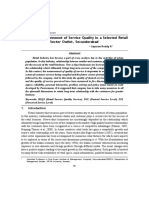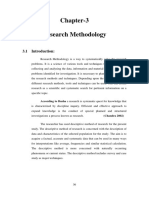Service Quality of Public Sector Banks - A Study: Management
Service Quality of Public Sector Banks - A Study: Management
Uploaded by
gherijaCopyright:
Available Formats
Service Quality of Public Sector Banks - A Study: Management
Service Quality of Public Sector Banks - A Study: Management
Uploaded by
gherijaOriginal Title
Copyright
Available Formats
Share this document
Did you find this document useful?
Is this content inappropriate?
Copyright:
Available Formats
Service Quality of Public Sector Banks - A Study: Management
Service Quality of Public Sector Banks - A Study: Management
Uploaded by
gherijaCopyright:
Available Formats
[Ramu et. al., Vol.5 (Iss.
7): July, 2017] ISSN- 2350-0530(O), ISSN- 2394-3629(P)
DOI: https://doi.org/10.29121/granthaalayah.v5.i7.2017.2173
Management
SERVICE QUALITY OF PUBLIC SECTOR BANKS - A STUDY
Dr. G.Ramu *1, V.Anbalagan 2
*1
Research Advisor and Assistant Professor, P.G and Research Department of Commerce, Thiru.
Vi. Ka. Govt. Arts College, Tiruvarur, India
2
Assistant Professor, P.G and Research Department of Commerce, M.R. Government Arts
College, Mannargudi, India
Abstract
The banking scenario in India is of a highly developed nature, even though it is still far from
achieving world standards in terms of size, products and services. Indian banks have realized that
along with organic growth there is a need to grow inorganically as well, in order to be
competitive with other players in the market. In this scenario, banking has been the focus of
attention for the banking industry. Gronross, a service marketing expert, proposed that a service
firm, in order to simultaneously attain success, must develop its service quality. Firstly, it must
define how the consumers perceive service quality and secondly, determine in what way service
quality is influenced. Consumers all over the world have become more quality conscious; hence
there has been an increased customer demand for higher quality service. Service operations
worldwide are affected by this new wave of quality awareness and emphasis. Therefore service-
based companies like the banks are compelled to provide excellent services to their customers in
order to have sustainable competitive advantage, especially in the current trend. This study
identifies quality dimensions significant to enable the banks to develop the strategies improving
the quality of service delivery. It is found through the present study that the public sector banks
in Karur district are losing market share to private and foreign banks. To survive in this
competitive scenario all public sector banks are forced to introduce innovative services, schemes
in order to retain existing customers and attract new customers.
Keywords: Service Quality; Private Sector Banks; Dimensions of Service Quality; Customer
Satisfaction and Banking Services.
Cite This Article: Dr. G.Ramu, and V.Anbalagan. (2017). “SERVICE QUALITY OF PUBLIC
SECTOR BANKS - A STUDY.” International Journal of Research - Granthaalayah, 5(7),
639-645. https://doi.org/10.29121/granthaalayah.v5.i7.2017.2173.
1. Introduction
Banking Services in India
The banking scenario in India is of a highly developed nature, even though it is still far from
achieving world standards in terms of size, products and services. Indian banks have realized that
Http://www.granthaalayah.com ©International Journal of Research - GRANTHAALAYAH [639]
[Ramu et. al., Vol.5 (Iss.7): July, 2017] ISSN- 2350-0530(O), ISSN- 2394-3629(P)
DOI: 10.5281/zenodo.844828
along with organic growth there is a need to grow inorganically as well, in order to be
competitive with other players in the market. In this scenario, banking has been the focus of
attention for the banking industry. The emergence of new economies and their rapid growth have
been the most important contributing factors in the resurgence of banking. Changing lifestyles,
rapid improvements in information technology and other service sectors, as well as increasing
levels of income, have contributed to the growth of banking services in countries like India that
are developing at a good pace. A decade ago, the banking sector was tough on a finger tip. But
now it is possible. All the bank transactions with a connection to mobile handsets technology is
the latest innovation means necessary to make. In addition, SMS Banking, Mobile Banking in
India, and all the modernization are the major steps taken by banks towards Internet banking and
ATMs. With all these tools and systems, banking has become a complete freedom to experience.
Accounting, fund transfer and payment for centuries, has been followed in physical bank check
which is now modernized. But the standing for hours in front of the cash counter and time to
withdraw your own money is in foundation. The Indian banks are vying with one another to grab
a pie of the banking service sector which has tremendous potential over the GDP in India. It also
has its share of challenges in retaining customers, introduction of tech-savvy facilities and
investments in such facilities, security concerns, Know Your Customer (KYC) norms,
credit evaluation norms, etc.
Concept of Service Quality
Lewis and Booms (1983) had suggested that service quality results from a comparison of what
customers expect from a service-provider with the provider’s actual performance. According to
them, “service quality is a measure of how well the service level delivered matches customer
expectations. Delivering quality service means conforming to customers expectations on a
consistent basis.”
Dimensions of Service Quality
While evaluating service quality, consumers examine the following aspects: tangibility,
reliability, responsiveness, assurance and empathy. Tangibility includes the service-provider’s
physical facilities, its equipment and appearance of the employees. Reliability is the ability of the
firm to perform the service promised dependably and accurately. Responsiveness is the
willingness of the firm’s staff to help customer and to provide him with prompt service.
Assurance refers to the knowledge and courtesy of the company’s employees and their ability to
inspire confidence in the customer. Empathy is caring and the individualized attention that the
service firm provides to each customer.
Managing Service Quality
Gronross, a service marketing expert, proposed that a service firm, in order to simultaneously
attain success, must develop its service quality. Firstly, it must define how the consumers
perceive service quality and secondly, determine in what way service quality is influenced. He
also suggested that the functional quality is an important dimension of perceived service than the
technical quality. Therefore, the essence of effectiveness in managing services lies in improving
the functional quality of a firm’s service by managing the buyer-seller interaction as compared to
traditional marketing activities.
Http://www.granthaalayah.com ©International Journal of Research - GRANTHAALAYAH [640]
[Ramu et. al., Vol.5 (Iss.7): July, 2017] ISSN- 2350-0530(O), ISSN- 2394-3629(P)
DOI: 10.5281/zenodo.844828
2. Review of Literature
The study of service quality of banking services and satisfaction level of bank customer has to
start with a review of earlier works conducted and theories developed in this area to give a
formal design to the present task. The reviews on the banking sector and the services involved
with are elaborated along with the literature studies of service quality and customer satisfaction
dimensions as follows:
Khan, Nisar Ahmed et al. (2005) conducted a study to examine the performance of scheduled
commercial banks in general and public sector banks in particular during the post reform period.
It also analyzed the performance of three categories of banks viz., public, private and foreign
banks by comparing their capital adequacy, asset quality, profitability and participation in rural
areas. It revealed that profitability and efficiency of these banks have improved considerably
during the period, but the participation in rural areas in terms of number of offices, growth of
credit, growth of deposits etc., have significantly declined during the reform period.
Krishnaveni, R. et al. (2005) analyzed the existing Indian banking scenario in the light of
liberalization and globalization reforms in the country. They also studied the perceptions of the
corporate customers regarding the service quality of their bankers. The study found that there is a
wide gap between the strategies followed by the Indian banks when compared to the foreign
banks. The situation is same in the case of customer perceptions of service quality.
Gopalakrishnan, V (2004) has inquired the challenges of Indian financial services market. This
study revealed that the entry of new foreign banks and private sector banks with their advanced
knowledge base of automation in the banking operations and aggressive marketing strategies has
pushed public sector banks to a tight corner. He wants the public sector banks, to survive and
succeed by identifying their marketing areas, develop adequate resources, and convert these
resources into healthy and efficient services and distribute them effectively satisfying the
manifold tastes of customers.
Prabha, Divya et al. (2006), in their study analyzed the service quality perceptions of the
corporate customers in Coimbatore regarding the services provided by their banks. For the study
they considered both product and service based sectors and SERVQUAL scale based
questionnaire for the survey. By this study it has been revealed that even though customers are
more satisfied with the competence and customer orientation dimensions of service quality, still
banks need to focus upon the aspects of communication, modernization and quickness of service.
Bhat, Mushtaq A. (2005) studied service quality perceptions of Indian banks in comparison with
that of foreign banks. SERVQUAL instrument developed by Parasuraman et al. in the year 1988
and its five dimensions such as reliability, responsiveness, empathy, assurance and tangibility
were used for collecting primary data. A major finding of the study was that Indian banks fall
much below the perceptions of their customers on all dimensions of service quality. Foreign
banks are exceeding the perceptions of their customers on tangibility and reliability dimensions
of service quality.
Http://www.granthaalayah.com ©International Journal of Research - GRANTHAALAYAH [641]
[Ramu et. al., Vol.5 (Iss.7): July, 2017] ISSN- 2350-0530(O), ISSN- 2394-3629(P)
DOI: 10.5281/zenodo.844828
Krishna Chithanya, V. (2005) studied the meaning, nature and scope of financial activities in
India and its features and to frame marketing strategy to attain service quality and to suggest
effective channel of distribution. By this study, service quality is the difference between the
perceptions of actual service quality and expectation of customers and the customer courtesy,
credibility and security. It proposed a two way channel for distributing financial services such as,
remote - T.V, Phone, PC etc., and face- to-face traveling, visiting offices etc.
Bauer, Hans H. et al. (2005) empirically examined characteristics of a website that transform
into an extensive e-banking portals and to analyze different facets of the quality of services
delivered through e-banking portals in order to process a service quality measurement model.
The measurement model constructed in this study was based on different dimensions such as
security and trust, basic service quality, cross-buying service quality, added value, transaction
support and responsiveness. Here, the identified dimensions were classified on the basis of its
nature as core services, additional services and problem solving services.
3. Need for Service Quality in Banks
The competitive climate in the Indian financial market has changed dramatically over the last
few years. Business houses have entered into financial service activities. Public sector banks
have started mutual fund trusts and other financial service subsidiaries. These subsidiaries have
introduced new products in the market, which have competitive edge over products of the other
banks. Even private sector and foreign banks have introduced innovative services. Almost all
Indian banks have started experimenting with new services by offering the Automatic Teller
Machine (ATM) that provides 24 hours services. The expectations of the customers have also
changed nowadays. Many consumers expect a variety of services from the banks. Many
household consumers, now, prefer to take consumer durable loans or buy an instant credit rather
than save for a few years to buy the intended consumer durable.
4. Scope of the Study
Consumers all over the world have become more quality conscious; hence there has been an
increased customer demand for higher quality service. Service operations worldwide are affected
by this new wave of quality awareness and emphasis. Therefore service-based companies like the
banks are compelled to provide excellent services to their customers in order to have sustainable
competitive advantage, especially in the current trend. Customer satisfaction and retention has
become a matter of concern in the banking industry and service quality has been identified
empirically as the driver of them. But, there are discrepancies between what the banks think is
quality service and what the customers expect from the banks.
5. Importance of the Study
This study identifies quality dimensions significant to enable the banks to develop the strategies
improving the quality of service delivery. This will enhance the Bank’s competitive position in
the banking industry and ensure survival of the bank, especially in this era of keen competition.
By measuring the satisfaction level of customers, financial institutions can develop customer-
centric service approach to deal with customers in order to avoid the tendency of existing
Http://www.granthaalayah.com ©International Journal of Research - GRANTHAALAYAH [642]
[Ramu et. al., Vol.5 (Iss.7): July, 2017] ISSN- 2350-0530(O), ISSN- 2394-3629(P)
DOI: 10.5281/zenodo.844828
customers switching to a competing bank. By identifying what customers expect and experience
what the quality is. Banks can revise, redesign or repackage its service operations and tailor them
to meet the expectations of the customers.
6. Statement of the Problem
The statement of problem enumerates the aspect of the current situation that the study is
performed for. It insists the need to verify a theory or a need to address problems and challenges
of policies and decision making in practice. After liberalization, privatization and globalization,
the Indian public sector banking is facing stiff competition from Indian private sector and foreign
banks. Private Banks and Foreign banks have been offering numerous innovative services in
order to attract customers from public sector banks.
7. Objectives of the Study
Following are the objectives of the present study:
1) To examine the profile of the customers utilizing the services rendered by banks.
2) To measure level of expectation of the customers towards the banking services.
3) To analyze the service quality dimensions to determine the quality of the services
provided by the banks.
4) To evaluate the level of satisfaction of the customers towards the banking services
5) To render suitable suggestions to refine the quality of banking services provided by the
banks.
8. Dimensions of the Study
The present study takes the following dimensions for its analysis.
Demographic factors of customers accessing banking services.
Customer expectation
Service quality of the Technical and Functional services provided by the banks.
Satisfaction of the Customers.
Customer retention.
The dimensions were further split into various sub dimensions.
9. Findings
The customers of the bank who are account holders are the respondents for this study and
their satisfaction varies in different transactional services of the bank. The variation may
be due to difference in quality or it can be in different cultural setting among service
providers and customers as well.
Service quality gaps in all dimensions including tangible, responsiveness, reliability,
empathy, communication, assurance and accountability exist. The expectations of
customers on factors measuring service tangibility yielded various average scores. Out of
the items, customers are very much interested in the efficiency and effectiveness of the
equipment used to deliver the services.
Http://www.granthaalayah.com ©International Journal of Research - GRANTHAALAYAH [643]
[Ramu et. al., Vol.5 (Iss.7): July, 2017] ISSN- 2350-0530(O), ISSN- 2394-3629(P)
DOI: 10.5281/zenodo.844828
10. Suggestions
Following are the suggestions for the development of the service quality of the public sector
banks:
Unnecessary formalities in providing loans and advances are the problems perceived in
this study area. Though the formalities are universal in nature, steps may be taken to
liberalize the procedures and formalities so that the people in this area may get the benefit
of getting loans quickly with reasonable formalities.
Most of the modernized services have not yet reached the branches of banks in this study
area. The banks can take steps to modernize their branches with computers and internet to
enable the customers to get quality services.
11. Conclusion
It is found through the present study that the public sector banks in Karur district are losing
market share to private and foreign banks. To survive in this competitive scenario all public
sector banks are forced to introduce innovative services, schemes in order to retain existing
customers and attract new customers. At this junction, it is imperative to identify the services
offered by public sector banking in Indian banking industry and to identify the determinants of
customer’s satisfaction towards public sector service quality.
References
[1] Bauer, Hans H. et al., (2005). Measuring the quality of e-banking portals, International Journal of
Bank Marketing, Vol. 23, No.2, pp. 153-1 75.
[2] Benson (2006), Reforms in Banking sector and their impact in banking services, SAJOSPS, July-
December, pp 77-81.
[3] Bhat, Mushtaq A. (2005), Correlates of service quality in banks: An Empirical Investigation,
Journal of Services Research, Vol. 5, No. l, April-September, pp 77-99.
[4] Dhar, Upindar et al. (2004), Service with a difference A Comparative analysis of private and
public sector banks, Prestige journal of Management and Research, Vo1.8, No. 12, April-
October, pp. 17-43.
[5] Golden, S. A. R. (2015). Regional Imbalance affecting quality of e-banking services with special
reference to Tuticorin District-An Analysis. International Journal of Research, 2(3), 788-798.
[6] Golden, S. A. R., & Franco, C. E. (2014). Role of Commercial Bank in the Growth of Micro and
Small Enterprises. Golden Research Thoughts, 3 (7), 1, 5.
[7] Golden, S. A. R., (2015). Satisfaction of Customers towards User Friendly Technological
Services offered by Public and Private Sector banks at Palayamkottai, Tirunelveli
District. International Journal of Research, 2(3), 775-787.
[8] Gopalakrishnan, V. (2004), Marketing of Banking Services in the globalised scenario -
Emergency challenges, Indian Journal of Marketing, Vol. 34, No.5, May, pp. 26-28.
[9] Khan, Nisar Ahmed and Rahmatullah, Md. (2005), Performance of Commercial banks in India,
Southern Economist, Vol. 44, No. l, May 1, pp 55-58.
[10] Krishnaveni, R and Divyaprabha, D. (2005), The impact of globalization on banking industry,
SAJOSPS, July-December, pp 74-80
[11] Lewis and Booms (1983), Service quality perceptions in banks: A comparative analysis, VISION
- The Journal of Business Perspective, Vol. 9, No.1, January-March, pp 11 – 19.
Http://www.granthaalayah.com ©International Journal of Research - GRANTHAALAYAH [644]
[Ramu et. al., Vol.5 (Iss.7): July, 2017] ISSN- 2350-0530(O), ISSN- 2394-3629(P)
DOI: 10.5281/zenodo.844828
[12] Prabha, Divya and Krishnaveni (2006). Service quality perception of banking service - with
reference to corporate customers, ACRM Journal of Business and Management Research, Vol. l,
No. 1, February, pp. 45-49.
[13] Sathye, Milind (2005), Privatization, Performance and efficiency: A Study of Indian banks,
VIKALPA, Vol. 30, No. 1, January-March, pp 7-16.
[14] Velmurugan R.and Vanitha E., (2015) Service Quality of Public Sector Banks, PARIPEX -
Indian Journal Of Research, Volume: 4 , Issue : 4, April 2015, p.4.
Http://www.granthaalayah.com ©International Journal of Research - GRANTHAALAYAH [645]
You might also like
- 5.1.4 Practice - Modeling - Multiplying PolynomialsDocument7 pages5.1.4 Practice - Modeling - Multiplying PolynomialsLyriq Wooten75% (4)
- Case Study DSMDocument31 pagesCase Study DSMvarun shivNo ratings yet
- Komatsu Hydraulic Excavator Pc228 Us 3 Shop ManualDocument20 pagesKomatsu Hydraulic Excavator Pc228 Us 3 Shop Manualhelen100% (64)
- SAP - New Batch Notes 1Document151 pagesSAP - New Batch Notes 1Niranjan BeheraNo ratings yet
- 11.customers' Perception Towards Service Quality of PDFDocument16 pages11.customers' Perception Towards Service Quality of PDFDr. P. MarishkumarNo ratings yet
- Exploring_international_tourists_perceptDocument12 pagesExploring_international_tourists_percepthasuprajapati38No ratings yet
- Service Quality Satisfaction and Customer LoyaltyDocument11 pagesService Quality Satisfaction and Customer LoyaltyJakia SultanaNo ratings yet
- The Impact of Service Quality Determinants On Customer Satisfaction A Study of Bank of Bhutan Limited in GEDU Town, BhutanDocument12 pagesThe Impact of Service Quality Determinants On Customer Satisfaction A Study of Bank of Bhutan Limited in GEDU Town, Bhutanarcherselevators100% (1)
- Title of The PaperDocument16 pagesTitle of The PapervikramkayshapNo ratings yet
- Customer Satisfaction in Indian Banking Services (A Study in Aligarh District)Document13 pagesCustomer Satisfaction in Indian Banking Services (A Study in Aligarh District)Siva Venkata RamanaNo ratings yet
- Customers Perception and Attitude Towards ServiceDocument17 pagesCustomers Perception and Attitude Towards ServiceDhrumil ModiNo ratings yet
- Munich Banking Gap AnalysisDocument9 pagesMunich Banking Gap AnalysisArpit JainNo ratings yet
- Customer Satisfaction On Services of Private Sector Banks in Erode District of TamilnaduDocument5 pagesCustomer Satisfaction On Services of Private Sector Banks in Erode District of TamilnaduJithinNo ratings yet
- Comparative Study of Customer Satisfacti PDFDocument27 pagesComparative Study of Customer Satisfacti PDFRAJKUMAR CHETTUKINDANo ratings yet
- Afroz - 2019 - Effect of Service Quality On Customer Satisfaction Evidence From Banks in TangailDocument15 pagesAfroz - 2019 - Effect of Service Quality On Customer Satisfaction Evidence From Banks in Tangailahmad abul a'laNo ratings yet
- A Study On Customers Satisfaction-1102-With-cover-page-V2 Ex ProjectDocument16 pagesA Study On Customers Satisfaction-1102-With-cover-page-V2 Ex ProjectFelix ChristoferNo ratings yet
- Banking Business Relationship (BBR) Topic:-Research ProjectDocument12 pagesBanking Business Relationship (BBR) Topic:-Research ProjectYashPalNo ratings yet
- Service Quality Gap Analysis in Private Sector Bank - A Customer PerspectiveDocument9 pagesService Quality Gap Analysis in Private Sector Bank - A Customer PerspectiveOmotayo AkinpelumiNo ratings yet
- F016214451 PDFDocument8 pagesF016214451 PDFramyaNo ratings yet
- Service Quality in The Retail Banking Sector-A Study of Selected Public and New Indian Private Sector Banks in IndiaDocument7 pagesService Quality in The Retail Banking Sector-A Study of Selected Public and New Indian Private Sector Banks in IndiaSowmya Reddy ReddyNo ratings yet
- Service Quality Gap Analysis in Private Sector Bank - A Customer PerspectiveDocument9 pagesService Quality Gap Analysis in Private Sector Bank - A Customer Perspectivemanoj kumar DasNo ratings yet
- 7.Md. Borak Ali - FinalPaperDocument12 pages7.Md. Borak Ali - FinalPaperiisteNo ratings yet
- Servqual ModelDocument16 pagesServqual Modelsharmamohit2000No ratings yet
- bmd11011 PDFDocument11 pagesbmd11011 PDFGiang Nguyen TrongNo ratings yet
- Customers' Satisfaction About Services Quality & Services Provided by BASIC Bank Ltd. - A Study On KhulnaDocument16 pagesCustomers' Satisfaction About Services Quality & Services Provided by BASIC Bank Ltd. - A Study On KhulnaDanudear DanielNo ratings yet
- Customer Satisfaction: A Comparative Study of Public and Private Sector Banks in BangladeshDocument8 pagesCustomer Satisfaction: A Comparative Study of Public and Private Sector Banks in BangladeshKRUPALI RAIYANINo ratings yet
- PROjECT 1Document12 pagesPROjECT 1Monisha satheeshaNo ratings yet
- Comparative Study of Customer Satisfaction in Public Sector and Private SECTOR BANKS IN INDIA (A Case Study of Meerut Region of U.P.)Document8 pagesComparative Study of Customer Satisfaction in Public Sector and Private SECTOR BANKS IN INDIA (A Case Study of Meerut Region of U.P.)VIKASH GARGNo ratings yet
- IJMSS6Oct19 8320 PDFDocument18 pagesIJMSS6Oct19 8320 PDFJithinNo ratings yet
- Ijfsm 2020 108876Document17 pagesIjfsm 2020 108876MD ROBEL HASANNo ratings yet
- Comparative Study On Customer Satisfaction Towards Banking Services: A Sustainable Mechanism For Growth of Banking IndustryDocument11 pagesComparative Study On Customer Satisfaction Towards Banking Services: A Sustainable Mechanism For Growth of Banking IndustrymariyaNo ratings yet
- JETIR2004427Document10 pagesJETIR2004427rubal gargNo ratings yet
- 5 Servqual and ServperfDocument13 pages5 Servqual and ServperfDidin Dimas Ponco AdiNo ratings yet
- Customer SatisfactionDocument13 pagesCustomer SatisfactionKarishma GuptaNo ratings yet
- 7 PDFDocument14 pages7 PDFSaiful BahriNo ratings yet
- Service Quality Customer Satisfaction and CustomerDocument10 pagesService Quality Customer Satisfaction and CustomerTanmay lalaNo ratings yet
- Customer Perception On Service Quality of Public and Private Banks Bhiwani Haryana IndiaDocument9 pagesCustomer Perception On Service Quality of Public and Private Banks Bhiwani Haryana Indiaak4705602No ratings yet
- Performance Appraisal in Indian Banking SystemDocument6 pagesPerformance Appraisal in Indian Banking Systemsagarsandeep090No ratings yet
- MPR Banking Service QualityDocument58 pagesMPR Banking Service Qualitypragya1301malhotraNo ratings yet
- Document From MeghalaDocument71 pagesDocument From Meghalameghumeghala796No ratings yet
- Chapter 1Document7 pagesChapter 1nishaNo ratings yet
- Customer Service of Banking. DUDocument19 pagesCustomer Service of Banking. DUkaiumNo ratings yet
- An Analysis of Customer PerceptionDocument28 pagesAn Analysis of Customer PerceptionAshis SahooNo ratings yet
- 246 655 1 SMDocument20 pages246 655 1 SMsarthakNo ratings yet
- BankDocument54 pagesBankSawant SwapnilNo ratings yet
- A Study On Measurement of ServDocument16 pagesA Study On Measurement of ServMɽ HʋŋteɽNo ratings yet
- 8724-Article Text-17102-1-10-20210530Document12 pages8724-Article Text-17102-1-10-20210530Please let me knowNo ratings yet
- Coca Cola Brand CateryDocument15 pagesCoca Cola Brand Cateryamith chathurangaNo ratings yet
- Services Rendered by Commercial Bank: A Customer Oriented Empirical Evidence From State Bank of IndiaDocument20 pagesServices Rendered by Commercial Bank: A Customer Oriented Empirical Evidence From State Bank of IndiaprathuprathapNo ratings yet
- Customer Satisfaction of Commercial Indian Bank Using SERVQUAL ModelDocument24 pagesCustomer Satisfaction of Commercial Indian Bank Using SERVQUAL ModelFaizan Ahmad67% (3)
- Interrelations Between Service Quality Attributes, Customer Satisfaction and Customer Loyalty in The Retail Banking Sector in Bangladesh - Kazi OmaDocument26 pagesInterrelations Between Service Quality Attributes, Customer Satisfaction and Customer Loyalty in The Retail Banking Sector in Bangladesh - Kazi OmaRiyan Adiputra PrayitnoNo ratings yet
- 1437 3214 1 SM PDFDocument8 pages1437 3214 1 SM PDFtaimoorNo ratings yet
- 2017 Impact of Service Quality in Customer SatisfactionDocument6 pages2017 Impact of Service Quality in Customer Satisfactionasankamail1987No ratings yet
- IJMBR - Volume 5 - Issue 3 - Page 189-206Document18 pagesIJMBR - Volume 5 - Issue 3 - Page 189-206Momin MohammadaliNo ratings yet
- A Study On E-Banking Service Quality and Customer SatisfactionDocument9 pagesA Study On E-Banking Service Quality and Customer Satisfactionmohak bettercalmemonuNo ratings yet
- 2023-Service Quality and Customer Satisfaction inDocument4 pages2023-Service Quality and Customer Satisfaction inHoàng AnhNo ratings yet
- Gap Analysis of HDFC BankDocument6 pagesGap Analysis of HDFC BankPragati KumariNo ratings yet
- Service Quality of Public Sector Banks in India A Gap Between Perception and ExpectationDocument6 pagesService Quality of Public Sector Banks in India A Gap Between Perception and ExpectationMANAV SAHUNo ratings yet
- Banking Service Quality Analysis in Facing ChallenDocument10 pagesBanking Service Quality Analysis in Facing ChallenHassenNo ratings yet
- T R A N S F O R M A T I O N: THREE DECADES OF INDIA’S FINANCIAL AND BANKING SECTOR REFORMS (1991–2021)From EverandT R A N S F O R M A T I O N: THREE DECADES OF INDIA’S FINANCIAL AND BANKING SECTOR REFORMS (1991–2021)No ratings yet
- Marketing of Consumer Financial Products: Insights From Service MarketingFrom EverandMarketing of Consumer Financial Products: Insights From Service MarketingNo ratings yet
- Gearing Up for Competitiveness: The Role of Planning, Governance, and Finance in Small and Medium-sized Cities in South AsiaFrom EverandGearing Up for Competitiveness: The Role of Planning, Governance, and Finance in Small and Medium-sized Cities in South AsiaNo ratings yet
- ADB Client Perceptions Survey 2020: Multinational Survey of StakeholdersFrom EverandADB Client Perceptions Survey 2020: Multinational Survey of StakeholdersNo ratings yet
- Paper 15Document10 pagesPaper 15gherijaNo ratings yet
- BANRF 2020 All Reports FormatDocument32 pagesBANRF 2020 All Reports FormatgherijaNo ratings yet
- ch-22Document22 pagesch-22gherijaNo ratings yet
- Annexures AditiDocument13 pagesAnnexures AditigherijaNo ratings yet
- Service Quality Dimension of E-Banking Services - A Study With Reference To Vellore DistrictDocument8 pagesService Quality Dimension of E-Banking Services - A Study With Reference To Vellore DistrictgherijaNo ratings yet
- Chapter-3 Research Methodology: According To Busha A Research Is Systematic Quest For Knowledge ThatDocument10 pagesChapter-3 Research Methodology: According To Busha A Research Is Systematic Quest For Knowledge ThatgherijaNo ratings yet
- Appendix (Questionnaire)Document4 pagesAppendix (Questionnaire)gherijaNo ratings yet
- Heavyweight vs. Lightweight Methodologies: Key Strategies For DevelopmentDocument6 pagesHeavyweight vs. Lightweight Methodologies: Key Strategies For DevelopmentgherijaNo ratings yet
- Impacts of Project Management Throughout ERP Implementation Life CycleDocument9 pagesImpacts of Project Management Throughout ERP Implementation Life CyclegherijaNo ratings yet
- It Vendor Management: Principles & PracticesDocument32 pagesIt Vendor Management: Principles & PracticesgherijaNo ratings yet
- Ifcb2009 98Document92 pagesIfcb2009 98gherijaNo ratings yet
- "Start With The End in Mind" - Stephen R. CoveyDocument13 pages"Start With The End in Mind" - Stephen R. CoveygherijaNo ratings yet
- Book Review Fundamentals of Research MetDocument28 pagesBook Review Fundamentals of Research MetgherijaNo ratings yet
- Matrix Algebra Tutor - Workdheet 8 - Solving Systems Using Matrix InversesDocument32 pagesMatrix Algebra Tutor - Workdheet 8 - Solving Systems Using Matrix InverseshindusaarthiNo ratings yet
- Module 3Document8 pagesModule 3GODIO, REINA JAMAICA R.No ratings yet
- Meanwhile Elsewhere Song Dynasty WorksheetDocument1 pageMeanwhile Elsewhere Song Dynasty Worksheetq0130No ratings yet
- ACCT3071 Research Methods in Accounting Summative Assignment Literature Review Due 2nd February 12 MiddayDocument5 pagesACCT3071 Research Methods in Accounting Summative Assignment Literature Review Due 2nd February 12 Middayqingxuankong3No ratings yet
- A Deep Dive Into Data QualityDocument8 pagesA Deep Dive Into Data QualitysparkaredlaNo ratings yet
- MNT - QC - BP - 001 Blasting & Painting ReportDocument1 pageMNT - QC - BP - 001 Blasting & Painting Reportsivagnanam s100% (1)
- p2 IJMODocument4 pagesp2 IJMOWeerasak Boonwuttiwong100% (2)
- Dicom Conformance Statement Hfa2i 5.0Document53 pagesDicom Conformance Statement Hfa2i 5.0justyna911No ratings yet
- 10000mah Mi 18W Fast Charge Power Bank 3 User ManualDocument7 pages10000mah Mi 18W Fast Charge Power Bank 3 User ManualΝικόλαος ΚερασιώτηςNo ratings yet
- Basic Calculus Grade 11 Quarter 4Document4 pagesBasic Calculus Grade 11 Quarter 4Kazandra Cassidy Garcia100% (1)
- Dfc10042 Lab Activity (Question)Document66 pagesDfc10042 Lab Activity (Question)lokeshNo ratings yet
- Recirculation Pump SizingDocument3 pagesRecirculation Pump SizingAkhil VijaiNo ratings yet
- Cloud Pak For Data BattlecardDocument4 pagesCloud Pak For Data BattlecardunfinishedscarfNo ratings yet
- 2u2i AND WBL-BASED PROGRAMS STUDENT-CENTERED LEARNING EFFICACY IN MALAYSIAN HIGHER EDUCATIONDocument18 pages2u2i AND WBL-BASED PROGRAMS STUDENT-CENTERED LEARNING EFFICACY IN MALAYSIAN HIGHER EDUCATIONGlobal Research and Development ServicesNo ratings yet
- Commercial Pca GL 0109 e LQDocument11 pagesCommercial Pca GL 0109 e LQPepi Rojas BenitoNo ratings yet
- The Beat Design ChecklistDocument1 pageThe Beat Design ChecklistsigmahustlingNo ratings yet
- Appficiency Reviews - GlassdoorDocument10 pagesAppficiency Reviews - GlassdoorRaghava R SNo ratings yet
- Narrative ReportDocument3 pagesNarrative ReportRamces SolimanNo ratings yet
- 62-61115-02 Supra 450Document75 pages62-61115-02 Supra 450nalvaradoNo ratings yet
- Java Unit-2Document25 pagesJava Unit-2manitechgamerNo ratings yet
- Chap 1306 - AkDocument52 pagesChap 1306 - AkJohnathan GriffithNo ratings yet
- HMT-1500-Technical Proposal for EVERRICH 10Document79 pagesHMT-1500-Technical Proposal for EVERRICH 10Sweet IslandNo ratings yet
- dgr10 2020 07 07Document18 pagesdgr10 2020 07 07centrum arvindNo ratings yet
- Samsung PDFDocument15 pagesSamsung PDFJelena Bieber100% (1)
- En Sample Paper 28 UnsolvedDocument13 pagesEn Sample Paper 28 UnsolvedPankaj BaidNo ratings yet
- LGR 7000XLi Owners Manual - 2015Document63 pagesLGR 7000XLi Owners Manual - 2015hqwaterNo ratings yet






































































































